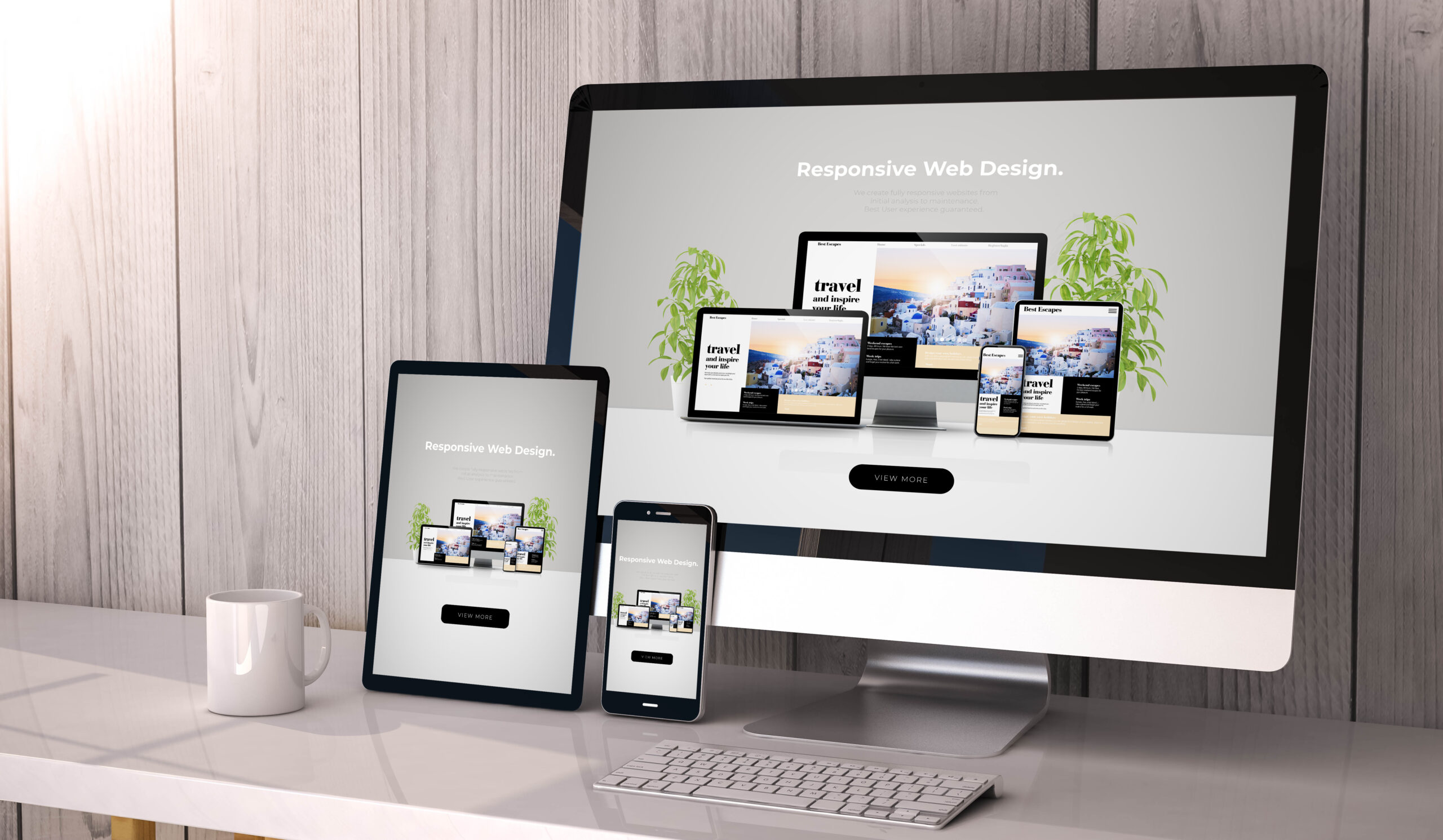At Web Design Knutsford, we understand that effective website design is more than just aesthetics. It’s about creating a user-friendly experience that draws visitors in and encourages them to engage with your brand. In this blog post, we’ll discuss the essential principles of effective website design that can help you achieve these goals and stand out in today’s digital landscape.
Simplicity
At Web Design Knutsford, we believe that simplicity is key when it comes to effective website design. By using a minimalist approach, with clean aesthetics and clear categories, you can create a site that communicates your content with clarity and ease of use.
One way to achieve this simplicity is through the strategic use of whitespace. Properly spaced elements not only enhance the visual appeal of your site but also improve communication by allowing users’ eyes to focus on important content without being overwhelmed by cluttered design. By keeping these principles in mind during website development, you can create an engaging user experience that encourages visitors to explore and engage with your brand.
Clear Navigation
Use a logical and intuitive menu structure to allow visitors to easily find what they are looking for. Your navigation bar should be simple and easy to use, with clear categories that are easy to understand. Ensure all important information is easy to find by putting it in the main menu or using prominent links on your homepage.
Make sure the navigation bar is visible and consistent on every page, so visitors can easily navigate through your site without getting lost. This will also help with communication between you and your audience, making sure they have access to everything they need at their fingertips. Clarity is key when it comes to website design; make sure you communicate effectively by using appropriate aesthetics such as font sizes and colors that stand out but aren’t overwhelming.
By following these principles of effective website design, you’ll ensure your content is accessible while maintaining an attractive appearance that doesn’t overwhelm users visually. At Web Design Knutsford, we take pride in creating websites that look great while being functional too – get in touch today if you’d like more advice!
Minimalism
When it comes to designing a website, minimalism is a key principle that can greatly improve its aesthetics and communication. Here are some essential tips to achieve minimalist design:
- Use a simple colour scheme with limited colours:
- Stick to two or three colours throughout the website for a cohesive look.
- Avoid clutter by only including essential elements on each page:
- Keep in mind that less is more, and prioritize clarity over quantity of content.
- Choose legible fonts and use them consistently throughout the website:
- Make sure the font size is large enough for easy reading.
By implementing these principles, your website will not only look visually appealing but also effectively communicate its content to users.
Whitespace
Allowing for plenty of white space between elements is a fundamental principle in website design. This creates a clean and uncluttered aesthetic, which enhances clarity and communication to the user. Grouping related content together using white space can also improve readability and help users navigate different categories.
Limiting text blocks to an appropriate length is another critical aspect of effective website design. Using whitespace to break up long paragraphs helps keep the reader engaged with your content, preventing them from tuning out or becoming overwhelmed by too much information at once. Overall, incorporating these principles into your design will make your website more aesthetically pleasing and improve its functionality for users.
Consistency
Consistency is key to effective website design. By maintaining a consistent colour scheme, typography and layout throughout the site, users can navigate with ease and feel comfortable using it. Avoid using too many colours or fonts as this can be overwhelming and confusing.
Ensure that your website’s consistency extends beyond just its visual elements. The tone of voice used in any written content should also remain consistent throughout the site, reinforcing brand identity and building trust with visitors. Consistency not only makes a website look professional but it also helps to establish credibility for your brand online.
Colour Scheme
Choosing the right colour scheme is a crucial aspect of effective website design. It is important to select colours that match your brand’s personality and values. Using contrasting colours can help draw attention to important elements like buttons or calls-to-action, making them more visible and clickable. However, it’s also essential to avoid using too many bright colours as this can overwhelm users and make the website look unprofessional.
When choosing a colour palette, consider your target audience and their preferences. A good tip is to use no more than three primary colours throughout the site for consistency and harmony in design. The combination should be easy on the eyes while still being eye-catching enough to maintain interest from visitors. By selecting an appropriate colour scheme that complements your brand, you’ll create a seamless user experience that will keep visitors engaged with your site longer!
Typography
When it comes to typography in website design, there are a few key principles to keep in mind. Firstly, selecting easy-to-read fonts for body text is crucial for ensuring that visitors can quickly and easily consume your content without any unnecessary strain on their eyes. Secondly, using larger font sizes for headings and subheadings helps create visual hierarchy and draws attention to important information. Finally, consistent use of font styles throughout the website helps maintain a cohesive look and feel.
At Web Design Knutsford, we understand the importance of effective typography in creating visually appealing websites that engage visitors and communicate your message effectively. That’s why we take great care in selecting fonts that balance readability with style, while also ensuring consistency across all pages of your website. By following these simple rules of typography design, we can help you create a website that looks great and delivers results!
Layout
Ensuring a clear hierarchy in the design of each page is crucial to effective website layout. Users should be able to quickly and easily identify the most important information on a page, whether that be through size, colour or placement.
Prioritizing content above the fold on each page ensures that users don’t need to scroll down before finding what they’re looking for. This helps keep users engaged with your site and can lead to higher conversion rates.
Using whitespace effectively is key in creating a clean and organized layout. It allows information to breathe, making it easier for users to read and understand. Additionally, using whitespace can help draw attention specifically where you want it by creating contrast between elements on the page.
- Ensure clear visual hierarchy
- Prioritize content above the fold
- Use whitespace effectively
Functionality
When it comes to website functionality, mobile responsiveness is crucial. With more and more people accessing the internet through their smartphones and tablets, a website must be able to adapt to different screen sizes. This not only enhances user experience but also affects search engine rankings.
In addition to being mobile-responsive, fast loading speeds are equally important for website functionality. Slow loading times can lead visitors to abandon the site altogether and negatively impact SEO performance. To maintain high traffic volume and retain users’ attention, ensuring speedy load times should be a top priority during web development.
Mobile Responsiveness
At Web Design Knutsford, we understand that mobile responsiveness is crucial for effective website design. That’s why our team of experts ensures that all websites we create are responsive and adaptable to different screen sizes. We prioritize thumb-friendly navigation, making it easy for users to navigate through your site using their mobile devices without difficulty.
To further enhance the user experience on mobile devices, flexible images and media are integrated into our designs. This means that all visual elements on your website will be optimized to load quickly and correctly on any device. With a focus on responsive design, Web Design Knutsford creates websites that look great and function seamlessly across desktops, tablets, and smartphones – maximizing accessibility for your target audience.
Fast Loading Speeds
Optimized images and videos, caching techniques, and minified CSS and JavaScript are essential for achieving fast loading speeds on a website. By implementing these principles of effective website design, users will be able to quickly access the content they need without having to wait around for pages to load.
Some tips for optimizing images and videos include compressing files or using lazy loading techniques. Caching can also improve page speed by storing frequently accessed data locally so that it doesn’t have to be retrieved from the server every time it’s needed. Additionally, minimizing CSS and JavaScript files removes unnecessary code which can slow down page rendering times.
By prioritizing fast loading speeds through optimized media files, caching techniques, and minimized code we ensure our client’s websites offer a quick user experience that keeps visitors engaged with their brand while fostering growth through increased traffic numbers as well as positive search engine rankings.
Accessibility
At Web Design Knutsford, we understand the importance of website accessibility for all users. One key aspect is clear and readable fonts that allow visitors to easily read and comprehend content. We ensure that font size, style, and spacing are optimized for user experience.
Another important aspect of accessibility is colour contrast ratio compliance. This ensures that text stands out from the background and can be read by individuals with visual impairments or in different lighting conditions. At Web Design Knutsford we adhere to WCAG 2.1 standards to ensure our designs meet these requirements.
Keyboard accessibility is also a crucial factor in website design, providing an alternative way for users who cannot use a mouse or touch screen devices to navigate through the site using only their keyboard controls. Our team tests websites on various browsers and assistive technologies such as screen readers ensuring ease of access for everyone regardless of their level of physical ability or disability.
Visual Appeal
At Web Design Knutsford, we understand the value of visual appeal when it comes to effective website design. High-quality images and graphics are essential components in attracting visitors and keeping them engaged on your site. Not only do they add aesthetic value, but they also help convey information quickly and effectively.
However, it’s not just about adding any image or graphic to your site. Brand consistency is equally important in creating a cohesive look that reflects your business’s values and message. By using consistent colours, fonts, imagery and layouts throughout your website, you build brand recognition while enhancing its overall visual appeal.
High-Quality Images and Graphics
We believe that high-quality images and graphics are crucial in creating an effective website design. To ensure a seamless user experience, we optimize image sizes for faster load times while maintaining their quality. This means that your visitors won’t be frustrated by slow-loading pages and can enjoy browsing your site without interruption.
Consistency is also essential when it comes to images and graphics on your website. We make sure to use a consistent colour scheme throughout all the visuals, which helps establish brand identity and professionalism. Finally, we only use relevant, high-resolution images to create engaging visual content that enhances the overall user experience of your website.
Brand Consistency
Consistent use of brand colours and fonts is key to establishing a memorable online presence. By incorporating your brand’s distinct colour palette and font selections throughout each page, you reinforce visual recognition with users. This consistency can inspire trust in your company, as it suggests an established professional image.
Incorporating the brand logo on all pages is another critical component of effective website design. A well-placed logo can strengthen user recognition and recall long after they’ve left your site. Therefore, ensure that it appears in multiple locations on every web page.
Clear representation of company values through design means ensuring that the look and feel of a website reflects the unique personality or mission statement behind its content. Whether using graphics or text-based elements to convey these values, this approach results in effective communication with users about what makes your business stand out from others within its market sector.






